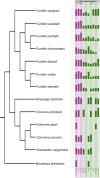Heteromorphic ZZ/ZW sex chromosomes sharing gene content with mammalian XX/XY are conserved in Madagascan chameleons of the genus Furcifer
- PMID: 38418601
- PMCID: PMC10901801
- DOI: 10.1038/s41598-024-55431-9
Heteromorphic ZZ/ZW sex chromosomes sharing gene content with mammalian XX/XY are conserved in Madagascan chameleons of the genus Furcifer
Abstract
Chameleons are well-known lizards with unique morphology and physiology, but their sex determination has remained poorly studied. Madagascan chameleons of the genus Furcifer have cytogenetically distinct Z and W sex chromosomes and occasionally Z1Z1Z2Z2/Z1Z2W multiple neo-sex chromosomes. To identify the gene content of their sex chromosomes, we microdissected and sequenced the sex chromosomes of F. oustaleti (ZZ/ZW) and F. pardalis (Z1Z1Z2Z2/Z1Z2W). In addition, we sequenced the genomes of a male and a female of F. lateralis (ZZ/ZW) and F. pardalis and performed a comparative coverage analysis between the sexes. Despite the notable heteromorphy and distinctiveness in heterochromatin content, the Z and W sex chromosomes share approximately 90% of their gene content. This finding demonstrates poor correlation of the degree of differentiation of sex chromosomes at the cytogenetic and gene level. The test of homology based on the comparison of gene copy number variation revealed that female heterogamety with differentiated sex chromosomes remained stable in the genus Furcifer for at least 20 million years. These chameleons co-opted for the role of sex chromosomes the same genomic region as viviparous mammals, lacertids and geckos of the genus Paroedura, which makes these groups excellent model for studies of convergent and divergent evolution of sex chromosomes.
Keywords: Chameleons; Homology; Karyotypes; Microdissection; Sex chromosomes; qPCR.
© 2024. The Author(s).
Conflict of interest statement
The authors declare no competing interests.
Figures




Similar articles
-
ZZ/ZW Sex Determination with Multiple Neo-Sex Chromosomes is Common in Madagascan Chameleons of the Genus Furcifer (Reptilia: Chamaeleonidae).Genes (Basel). 2019 Dec 6;10(12):1020. doi: 10.3390/genes10121020. Genes (Basel). 2019. PMID: 31817782 Free PMC article.
-
Female heterogamety in Madagascar chameleons (Squamata: Chamaeleonidae: Furcifer): differentiation of sex and neo-sex chromosomes.Sci Rep. 2015 Aug 19;5:13196. doi: 10.1038/srep13196. Sci Rep. 2015. PMID: 26286647 Free PMC article.
-
The rise and fall of differentiated sex chromosomes in geckos.Mol Ecol. 2019 Jun;28(12):3042-3052. doi: 10.1111/mec.15126. Epub 2019 Jun 28. Mol Ecol. 2019. PMID: 31063656
-
Lizards as Model Organisms of Sex Chromosome Evolution: What We Really Know from a Systematic Distribution of Available Data?Genes (Basel). 2021 Aug 28;12(9):1341. doi: 10.3390/genes12091341. Genes (Basel). 2021. PMID: 34573323 Free PMC article. Review.
-
Sex chromosome evolution in lizards: independent origins and rapid transitions.Cytogenet Genome Res. 2009;127(2-4):249-60. doi: 10.1159/000300507. Epub 2010 Mar 23. Cytogenet Genome Res. 2009. PMID: 20332599 Review.
Cited by
-
Highlighting chromosomal rearrangements of five species of Galliformes (Domestic fowl, Common and Japanese quail, Barbary and Chukar partridge) and the Houbara bustard, an endangered Otidiformes: banding cytogenetic is a powerful tool.Comp Cytogenet. 2024 Dec 3;18:213-237. doi: 10.3897/compcytogen.18.135056. eCollection 2024. Comp Cytogenet. 2024. PMID: 39664601 Free PMC article.
-
New Insights on Chromosome Diversification in Malagasy Chameleons.Animals (Basel). 2024 Sep 30;14(19):2818. doi: 10.3390/ani14192818. Animals (Basel). 2024. PMID: 39409767 Free PMC article.
References
-
- Pla S, Maynou F, Piferrer F. Hermaphroditism in fish: Incidence, distribution and associations with abiotic environmental factors. Rev. Fish Biol. Fish. 2021;31:935–955. doi: 10.1007/S11160-021-09681-9. - DOI
MeSH terms
Grants and funding
LinkOut - more resources
Full Text Sources

